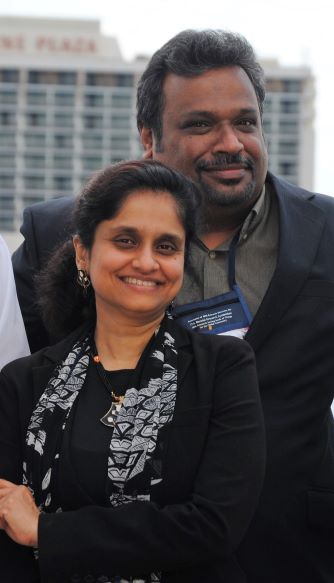
Tuesday, February 4, 2020
Dr. Madhumi Mitra, professor of biological and environmental sciences, and her husband, Dr. Abhijit Nagchaudhuri, professor of engineering, have completed a project four years in the making – a textbook on bioenergy.
“Practices and Perspectives in Sustainable Bioenergy: A Systems Thinking Approach” stands out, Mitra said, because it is a contributed volume with each original chapter written by experts in their respective fields of research and teaching in bioenergy, bio-products and sustainability.
Contributors include chemists, biologists, mechanical, chemical and agricultural engineers; environmental scientists, physicists and experts in business. Joining Mitra and Nagchaudhuri were UMES faculty members Dr. Kausiksankar Das, associate professor of physics, Dr. Monisha Das, associate professor of business, management and accounting, and Dr. Xavier Henry, lecturer in aviation sciences along with colleagues from such institutions as Cornell, Rutgers and West Virginia University.
“The robust collaboration is the reason the book took so long to complete from the submitted proposal to … the publisher through three rounds of review and revisions, to the final product,” Mitra said. “It was an arduous task.”
The 283-page book presents “a systems approach to bioenergy and provides a means to capture the complexity of bioenergy issues, including both direct and indirect impacts across the energy economy.” It addresses critical topics such as: systems thinking; sustainability, biomass; feedstocks of importance and relevance; anaerobic digestion and biogas; biopower and bioheat; and policies, economy, and rights to access to clean energy.
Six out of the 12 chapters were written by husband and wife teams.
“When you work together, you bring out the best,” Mitra said. “Everyone gave more than 100 percent effort.”
She explained the chapters published went through the meticulous process of not only being reviewed by Mitra, but by three to four independent reviewers selected by Springer (the publisher). Feedback was then shared with the authors, and revisions were made.
Each chapter, she said, includes a review with highlights of the key points, critical-thinking questions and a glossary.
“The open-ended questions create the opportunity for readers to hone their skills, explore, and think out of the box,” she said.
The book can be used by advanced undergraduates and graduate students as a primary or secondary textbook in courses related to sustainable bioenergy and bio-products. Researchers, professionals and policy makers will also be able to use it for current reference materials.
“There isn’t a book with the current state of knowledge by original contributors like it,” Mitra said. “Students can see that we (professors) do state-of-the-art research (and) that we are able to share (it) with the scientific community.”
The hard copy of the book will be the focus of a celebration with a launch seminar at UMES in this May — with the interdisciplinary collaborators invited to attend. Another launch is slated for the annual meeting of the American Society of Engineering Education, where Mitra and Nagchaudhuri have served in different capacities including division chairs with the Energy Conversion and Conservation Division.
“All of us are very excited about this endeavor,” Mitra said. “We are thankful to the contributing authors for being patient and for believing in us that this would come to fruition.”
The textbook, which retails for $79.99, is available at www.springer.com.
Mitra received her doctoral degree in plant biology from North Carolina State University. Her research interests include: micro and macro-algal ecology; seaweeds in human health and nutrition; biomonitoring and biosorption potential of seaweeds and seagrasses; bioenergy from algae; water quality; and reconstruction of the past environment and climate from microfossils.
Nagchaurhuri earned his doctorate in mechanical engineering from Duke University. His research interests include: biofuels and other forms of renewable energy; engineering mechanics; robotics and control systems; and precision agriculture and remote sensing.

